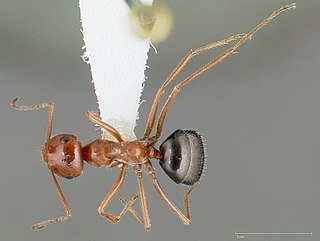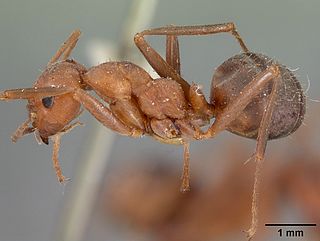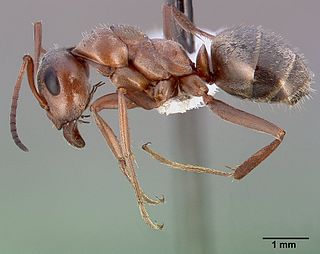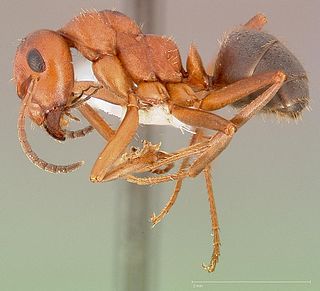
Honeypot ants, also called honey ants, are ants which have specialized workers that consume large amounts of food to the point that their abdomens swell enormously. Other ants then extract nourishment from them, through the process of trophallaxis. They function as living larders. Honeypot ants belong to any of several genera, including Myrmecocystus and Camponotus. They were first documented in 1881 by Henry C. McCook, and described further in 1908 by William Morton Wheeler.

Myrmecocystus, is a North American genus of ants in the subfamily Formicinae. It is one of five genera that includes honeypot ants. Worker ants keep and tend plerergates, which are other ants that store large quantities of nutritious fluid in their abdomens to feed the colony during famine times. Some species engage in highly territorial tournaments, which can result in intraspecific slavery. During the raids, they carry off larvae, workers, and plerergates. The genus has three subgenera, namely Myrmecocystus, Endiodioctes, and Eremnocystus.

Formica comata is a species of ant in the family Formicidae.

Myrmecocystus wheeleri is a species of honeypot ant native to California, Baja California, and Coahuila.

Myrmecocystus placodops is a species of honeypot ant native to the southwestern United States and northern Mexico.

Formica integra is a species of ant in the family Formicidae.

Myrmecocystus kennedyi is a species of honeypot ant in the subgenus Endiodioctes native to the western United States and western Mexico.

Formica gagatoides is a species of ant in the family Formicidae. It is found in Europe.

Formica difficilis is a species of ant in the family Formicidae.
Actenodes mendax is a species of metallic wood-boring beetle in the family Buprestidae. It is found in North America.

Formica integroides, also known as the Vinegar Ant, is a species of ant in the family Formicidae.

Myrmecocystus semirufus is a species of honeypot ant native to the western United States, Baja California, and Sonora.

Formica aerata, the grey field ant, is a species of ant in the family Formicidae.

Formica aserva is a species of ant in the family Formicidae. The species is a social parasite of other Formica species.

Formica limata is a species of ant in the family Formicidae.

Dyscinetus is a genus of rice beetles in the family Scarabaeidae. There are more than 20 described species in Dyscinetus.

Formica manni is a species of ant in the family Formicidae.

Formica argentea is a species of ant in the family Formicidae.

Formica densiventris is a species of ant in the family Formicidae.

Myrmecocystus flaviceps is a species of honeypot ant in the subgenus Endiodioctes native to the western United States, western Mexico, and Hidalgo.


















